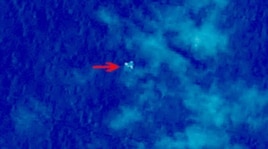The
Royal Malaysian Navy corvette KD Terengganu and a U.S. Navy MH-60R Sea
Hawk helicopter conduct a coordinated air and sea search for a missing
Malaysian Airlines jet in the Gulf of Thailand, March 12, 2014. (U.S.
Navy photo by Operations Specialist 1st Class Claudia Franco)
March 13, 2014
A U.S. official involved in the search for the missing Malaysian plane
says the jet may have been flying four hours after it disappeared from
radar screens.
The official said the jet was sending out a pinging signal -- a sign it was trying to communicate with a satellite. He said the plane may have flown another 4,000 kilometers after controllers reported it missing.
The United States is expanding its search for the plane into the Indian Ocean -- far west of its intended flight path.
Aircraft and ships from 12 countries are looking for the Boeing 777, but so far have found nothing to clear up the mystery. Authorities have ruled nothing out, including a massive technical failure, terrorism or the possibility that the pilot wanted to commit suicide.
The U.S. says the search for the missing Malaysian passenger jet may be extended to the Indian Ocean, far to the west of the last confirmed contact with the aircraft carrying 239 people.
Watch related video by VOA's Pam Dockins:
White House spokesman Jay Carney said Thursday there was new information -- though not necessarily conclusive -- that the Boeing 777 may have veered far off course from its intended flight path from Kuala Lumpur to Beijing and headed toward the Indian Ocean.
Carney said the U.S. was consulting with other nations involved in the massive effort to find the jetliner to see what ships and aircraft could be deployed to the Indian Ocean to expand the search operations.
Searchers looking for the missing Malaysian passenger jet over vast expanses of water in Asia have been stymied for six days.
The official said the jet was sending out a pinging signal -- a sign it was trying to communicate with a satellite. He said the plane may have flown another 4,000 kilometers after controllers reported it missing.
The United States is expanding its search for the plane into the Indian Ocean -- far west of its intended flight path.
Aircraft and ships from 12 countries are looking for the Boeing 777, but so far have found nothing to clear up the mystery. Authorities have ruled nothing out, including a massive technical failure, terrorism or the possibility that the pilot wanted to commit suicide.
The U.S. says the search for the missing Malaysian passenger jet may be extended to the Indian Ocean, far to the west of the last confirmed contact with the aircraft carrying 239 people.
Watch related video by VOA's Pam Dockins:
White House spokesman Jay Carney said Thursday there was new information -- though not necessarily conclusive -- that the Boeing 777 may have veered far off course from its intended flight path from Kuala Lumpur to Beijing and headed toward the Indian Ocean.
Carney said the U.S. was consulting with other nations involved in the massive effort to find the jetliner to see what ships and aircraft could be deployed to the Indian Ocean to expand the search operations.
Searchers looking for the missing Malaysian passenger jet over vast expanses of water in Asia have been stymied for six days.
- 1937: Amelia Earhart disappears during flight over Pacific, no trace of plane found
- 1996: TWA Flight 800, en route to Paris from New York, explodes over Long Island, questions remain over cause
- 1999: EgyptAir Flight 990 crashes into Atlantic while headed to Cairo from New York; US questions if pilot comments indicated suicide mission
- 2009: Air France Flight 447 goes down over Atlantic while traveling from Rio de Janeiro to Paris, crash report indicates pilot confusion
Malaysian Transportation Minister Hishamuddin Hussein rejected reports that Flight 370 continued flying for several hours after its last known contact and said that Chinese satellite images purporting to show debris from the aircraft in the waters south of Vietnam proved to be another fruitless lead.
"We deployed our assets but found nothing," he said.
Hishamuddin said Malaysia Airlines (MAS) asked plane maker Boeing and engine manufacturer Rolls Royce about purported data showing the plane could have flown an extra 4,000 kilometers over four hours.
"Since today's media report, MAS has asked Rolls Royce and Boeing specifically about the data. As far Rolls Royce and Boeing are concerned, those reports are inaccurate."
The report by the Wall Street Journal on Thursday cited the belief of U.S. officials based on data that is automatically sent by the plane's engines to the ground.
The Chinese satellite images emerged Wednesday, with state media saying they showed three fairly large objects near the plane's original flight path toward Beijing. But Hishamuddin said Malaysia later contacted the Chinese Embassy, which said the images were released by mistake and did not show any debris from the plane.
He said the Boeing 777 plane was "fit to fly," with its last inspection in February and its next one not due until June.
He also praised the ongoing search effort, which involves more than 80 ships and aircraft from 12 countries looking in an area that covers 93,000 square kilometers on either side of Malaysia.
"The overwhelming support and unprecedented effort on a multinational level, that is something that we should be very proud about, though we need to find the aircraft," he said.
Embed Code is invalid or incomplete.




Comments